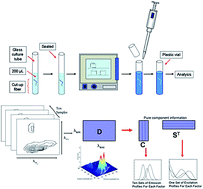Excitation–emission matrix fluorescence spectroscopy combined with MCR-ALS as a tool for the forensic analysis of similar and dissimilar sets of textile fiber extracts
Abstract
Trace textile fiber evidence is found at numerous crime scenes and plays an important role in linking a suspect to the respective scene. In this work, investigations into the fluorescence of fiber dyes and fibers themselves, as well as a methodology for discriminating between fibers using room temperature fluorescence (RTF) are reported. Initial systematic analysis was conducted on dye standards and extracts taken from fibers colored with the respective dyes of interest. Absorbance, excitation and fluorescence spectra were compared between standards and extracts to determine the optimal area of the fiber to investigate dyes, fluorescent impurities or the whole fiber. High performance liquid chromatography investigations were performed to obtain detailed information on the number of dye and fluorescent components present in extracts. Three-way Excitation Emission Matrix (EEM) data were found to give the greatest amount of spectral information and provide the highest level of discrimination. Successful discrimination between non-similar and similar fibers was achieved with the aid of second order MCR-ALS chemometric analysis. The level of discrimination obtained via RTF-EEM spectroscopy was sufficient to differentiate among two types of visually indistinguishable fibers and among fibers obtained from two separate cloths of the same material and colored with the same dye reagent.


 Please wait while we load your content...
Please wait while we load your content...